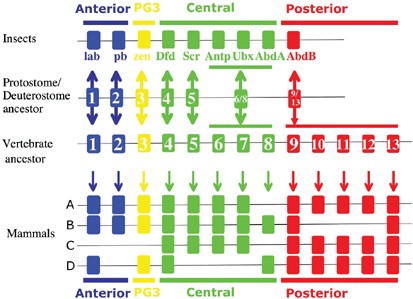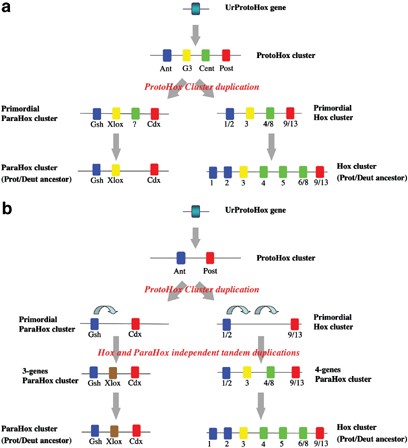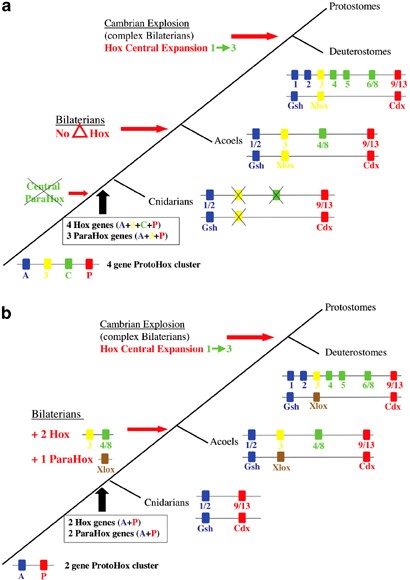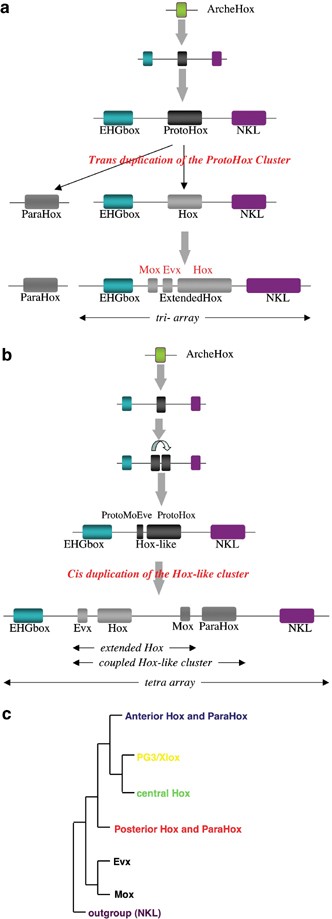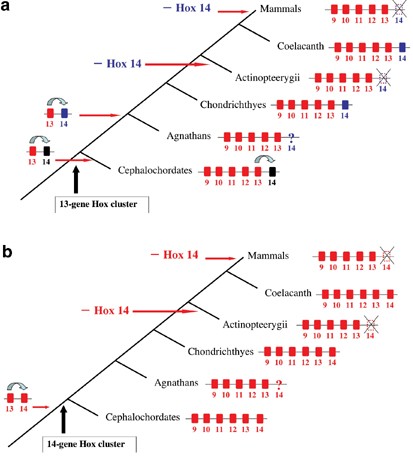Hox, ParaHox, ProtoHox: facts and guesses (original) (raw)
Since Edward Lewis' seminal work on the Bithorax complex of Drosophila (Lewis. 1978), the Hox gene cluster has fascinated evolutionary and developmental biologists alike. Hox genes belong to a class of homeobox genes, a major class of transcription factors regulating many aspects of development (Gellon and McGinnis, 1998). The discovery of the homeobox in 1984 (McGinnis et al, 1984) and the finding that similar genes act in similar ways in animals as diverse as flies and mice facilitated the reconciliation of developmental and evolutionary biologists. This came after a century of tormented relationships that followed an initial honeymoon, inspired by the Darwinian ‘descent with modification’ theory of evolution (‘community of embryonic structure reveals community of descent’, Darwin, 1859). Since then, experimental embryologists have concentrated on unravelling the mechanisms of embryological processes, while evolutionary biologists have followed the changes of gene frequencies in natural populations. Now, the new field of Evo-Devo, at the frontier of both disciplines, seeks a new ‘developmental synthesis of evolution’ (Gilbert, 2003). The conservation of Hox genes galvanized the Evo-Devo community and served to define the concept of the metazoan ‘zootype’, a conserved set of genes patterning the antero-posterior body axis (Slack et al, 1993). Soon after that, changes in Hox gene numbers, sequence, and regulation were invoked for body plan evolution and diversification (eg Gellon and McGinnis, 1998; Wagner et al, 2003; Amores et al, 2004).
What made Hox genes special among developmental regulators is not only their organization in chromosomal complexes, with nine genes in flies and 39 genes in four clusters in mammals (Figure 1), but also the phenomenon of spatial and temporal colinearity. Genes at one end of the cluster are expressed, and pattern the anterior end of the embryo, while genes at the other end of the cluster pattern the posterior end (Duboule and Dollé, 1989). This spatial colinearity (5′ equals posterior, 3′ equals anterior) is a direct consequence in some lineages (mainly vertebrates) of temporal colinearity. Genes at the 3′ end of the cluster are expressed earlier in development than genes at the 5′ end (Duboule, 1994); hence, temporal colinearity in developmental systems that grow from anterior to posterior leads immediately to spatial colinearity. The molecular mechanisms of colinearity are elusive, although chromatin remodelling and the physical topography of chromosomal regions have recently been implicated (Duboule and Deschamps, 2004).
Figure 1
Structure of the insect and mammalian Hox clusters and the cluster structure inferred for the last common ancestor of Protosotomes and Deuterostomes, and for the last vertebrate ancestor, prior to the cluster duplications in the vertebrate lineage (but see Figure 5 for alternative views). Hox genes are grouped in Anterior, Group3, Central, and Posterior classes based in sequence similarities. Numbers and arrows indicate orthology relationships.
The evolution of Hox genes in metazoans is still not fully understood. Comparison of mammalian and arthropod Hox clusters has led to general agreement that the last common ancestor of Protostomes and Deuterostomes, the two groupings of ‘higher’ metazoans, had a single Hox cluster composed of seven genes (Figure 1): two from the Anterior Group (paralogous groups (PGs) 1–2 in mammals, Drosophila genes labial and proboscipedia), one Group 3 gene (PG3, Drosophila zen gene), three representatives of the Central Group (PGs4–5, Drosophila Deformed and sex-comb reduced, and an ancestor of PGs6–8, Drosophila Antennapedia, Ultrabithorax and Abdominal-A), and a single Posterior Group gene (ancestor of PGs9–13, Drosophila Abdominal-B). In both Protostome and Deuterostome lineages, this original cluster followed distinct evolutionary pathways, with additional tandem duplications in the central and posterior region that account for the present-day composition of the complexes (reviewed in de Rosa et al, 1999; Ferrier and Minguillón, 2003).
The Hox cluster was believed to originate by tandem duplication from an ancestral ‘central’ Hox gene until 1998, with the discovery of the ParaHox cluster (Brooke et al, 1998), an evolutionary sister complex of the Hox cluster. This finding indicated that a hypothetical ProtoHox cluster of four genes duplicated early in animal evolution, giving rise to two twin clusters. These would be the primordial Hox cluster, which expanded by cis duplication to eight genes in Drosophila, or to 13 paralogous groups in mammals, and the primordial ParaHox cluster, which lost one member and gave rise to the three-gene complex maintained at least in cephalochordates and vertebrates (Figure 2a). Here, I summarize recent data on Hox and ParaHox genes and cluster contents in distinct lineages, and discuss various hypotheses for the evolution of Hox and ParaHox gene clusters. In particular, I discuss: (i) the origin and original structure of the Hox and ParaHox clusters, pointing to the evolutionary changes that accompanied the origin of Bilaterians and the Cambrian Explosion, (ii) the ‘accompanying’ genes of the Hox and ParaHox clusters, or whether the ProtoHox cluster duplication was a cis or a trans event, and (iii) the basal content of the Hox gene cluster in the vertebrate lineage.
Figure 2
Genesis and evolution of the Hox and ParaHox clusters. (a) Four-gene model ProtoHox cluster. A ProtoHox cluster containing four genes, one of each class (Anterior, PG3, Central, and Posterior) duplicated giving raise to the Primordial Hox and ParaHox clusters. The ParaHox cluster lost a Central gene, and the Hox cluster expanded up to seven members in the last common ancestor of Protostomes and Deuterostomes. (b) Two-gene model of the ProtoHox cluster. A ProtoHox cluster containing two genes (one Anterior and one Posterior) gave rise, by duplication, to the Primordial, two-gene containing, Hox and ParaHox clusters. The composition of the three- and four-gene containing ParaHox and Hox clusters, respectively, was due to single gene tandem duplications, independently in both clusters. Later in evolution, the four-gene Hox cluster further expanded by tandem duplication, up to seven genes in the last common ancestor of Protostomes and Deuterostomes.
Guess 1: Two or four? The ProtoHox cluster
The finding of three Hox-related genes closely linked in the amphioxus genome, AmphiGsh, AmphiXlox, and AmphiCdx, plus their phylogenetic relationship to the Hox clusters led to the ProtoHox cluster hypothesis (Brooke et al, 1998). Based on sequence similarity, Hox genes can be classified in four groups: the Anterior Group (PGs1–2), Group3, Central Group (PGs4–8) and Posterior Group (PGs9–13). Gsh genes are more closely related to Hox Anterior Group genes than to other ParaHox genes; Xlox is more similar to Hox Group3, and Cdx is more similar to Hox Posterior Group genes. Hence, the model predicts a ProtoHox complex with four genes (Figure 2a): An Anterior ProtoHox gene, ancestor of an Anterior Hox gene (PG1/2) and an Anterior ParaHox (Gsh) gene, a Group 3 ProtoHox gene (ancestor of Hox PG3 and Xlox), a Central ProtoHox gene, (ancestor of a Central Hox gene (PG4/8), a central ParaHox was lost soon after ProtoHox cluster duplication), and a Posterior ProtoHox gene (ancestor of a Posterior Hox gene PG9/13 and Cdx). New discoveries on the ParaHox cluster (eg Finnerty and Martindale, 1999; Yanze et al, 2001; Ferrier and Holland, 2003; Cook et al, 2004) and reviews on Hox/ParaHox evolution (eg Ferrier and Holland, 2001; Martínez and Amemiya, 2002; Ferrier and Minguillón, 2003) always present an evolutionary framework with a ProtoHox cluster with four genes. Here, I propose an alternative scenario for the structure of the ProtoHox cluster and the primordial Hox and ParaHox clusters, which takes into account a reconsideration of the available data and recent discoveries on lower metazoans.
Brooke et al (1998) proposed that the ProtoHox cluster duplicated at the same time as the Cambrian Explosion, when major protostome and deuterostome phyla appeared. However, it was soon found that dipoblast Cnidarians already possessed Hox and ParaHox genes (Finnerty and Martindale, 1999). Hence, ProtoHox cluster duplication must have occurred before the divergence of Cnidarians and Tripoblastic Animals. The search for Hox and ParaHox in Dipoblast animals has been intense. Distinct species of Cnidarians, Anthozoans, Hydrozoans, Cubozoans, and Scyphozoans, have been extensively searched for Hox and ParaHox genes. A major consensus is emerging (summarized in Finnerty, 2003; Finnerty et al, 2004): the basal content of the Cnidarian Hox/ParaHox clusters was one Anterior and one Posterior Hox gene, and one Anterior and one Posterior ParaHox gene (Figure 3). Despite intense efforts, no PG3 or central Hox or ParaHox genes have been found in any Cnidarian species. Thus, two conclusions are possible: (i) according to the four-gene ProtoHox cluster model, PG3 Hox and ParaHox were lost in all Cnidarians, and a central ParaHox was lost in all Cnidarians and Bilaterians (Figure 3a), or (ii) The ProtoHox cluster and the primordial Hox and ParaHox clusters had only Anterior and Posterior genes, in other words, the ProtoHox cluster consisted of only two genes (Figure 2b).
Figure 3
Changes in Hox and ParaHox numbers associated to major Metazoan Transitions. (a) Under the four-gene ProtoHox model, the origin of Bilaterians was not accompanied by changes in Hox or ParaHox gene numbers. In addition, Cnidarians lost at least three Hox and ParaHox genes. (b) Under the two-gene ProtoHox model, the origin of Bilaterians was coincident by the invention of two Hox (PG3 and Central groups) and one ParaHox (Xlox) classes.
The four-gene model is supported by phylogenetic analyses of the 60 aa homeodomain alone (or the homeodomain plus five flanking aa), of proteins that diverged more than 800 million years ago (Banerjee-Basu and Baxevanis, 2001; Peterson et al, 2004). The bootstrap values for any particular grouping of Hox vs ParaHox genes range from 40 to 70% (Brooke et al, 1998; Finnerty and Martindale, 1999; Banerjee-Basu and Baxevanis, 2001; Minguillón and Garcia-Fernàndez, 2003). These values are far below the confidence rate of phylogenetic analyses with 18S RNA or full protein sequences to establish the relationships among early divergent clades (Hillis and Bull, 1993). In addition, the four-gene cluster model necessarily implies that two classes of Hox genes (Group 3 and Central) and one (Group 3) or two (Group 3 plus Central) ParaHox genes were independently lost in the Cnidarian lineage (Figure 3a). Furthermore, two genes rather than four in Cnidarians may be more consistent with evolutionary considerations (Figure 3b). Hox genes in Bilaterians pattern the antero-posterior body axis. Cnidarian Hox genes display staggered expression along the oral-aboral axis (Finnerty, 2003; Finnerty et al, 2004), although data on the polarity of such expression are puzzling (Masuda-Nakagawa et al, 2000; Yanze et al, 2001; Finnerty, 2003; Finnerty et al, 2004). Colinearity of Hox genes in Cnidarians, if any, is consequently difficult to reconcile with only two Hox genes.
Recent data on the Hox complement of early Bilaterians help us to envisage alternative scenarios. Recent progress in molecular phylogeny has shown that Acoelomorphs (Acoela+Nemertodermatida), former members of the protostomian phylum Platyhelminthes, represent the earliest extant bilaterian clade (Ruiz-Trillo et al, 1999, reviewed in Baguñà and Riutort, 2004). Hence, the privileged intermediate position of Acoelomorpha, as a simple, unsegmented, acelomated Bilaterian, may help us to understand the evolution of Hox clusters. Do Acoels have ‘canonical’ higher bilaterian Hox and ParaHox clusters (seven Hox genes + three ParaHox genes), or do they possess an early version of Hox and ParaHox clusters? The Cnidarian/Bilaterian transition may have been accompanied by an increase in the numbers of Hox and ParaHox genes, as they are implicated in the diversification of the antero-posterior body axis. If the four-gene model is correct, and the common ancestor of Cnidarians and Bilaterians already had four Hox genes and three to four ParaHox genes, one would expect to find more complex clusters in Acoels (eg up to the seven-gene Hox cluster of the last common ancestor of Protostomes and Deuterostomes). If the two-gene model is correct and Cnidarians represent this old condition, one would expect to find more than two genes in the Acoel clusters. Very recent data (Cook et al, 2004; Baguñà and Riutort, 2004) strongly suggest that Acoels possesses a Hox cluster with four genes (one Anterior, one Group 3, one Central, and one Posterior members) and a ParaHox cluster with three genes, one of each canonical class. Hence, under the four-gene model (Figure 3a), the Cnidarian/Bilaterian transition was not accompanied by an increase in the Hox or ParaHox complement but, if the two-gene model is correct (Figure 3b), the Cnidarian/Bilaterian transition was accompanied by the emergence of two Hox genes (Group 3 and Central), and one ParaHox gene (Xlox). It is attractive to imagine that clusters with at least three genes were powerful tools to differentially pattern the newly acquired antero-posterior axis of Bilaterians, in contrast to the early two-gene clusters of Cnidarians.
Intermediate hypotheses can also be advanced, for example, a ProtoHox cluster with three genes (Anterior, Group3 and Posterior). In this case, Cnidarians would have lost PG3 and Xlox, and the increase in complexity at the origin of Bilaterians would have been linked only to the origin of a Central Hox gene. This model squares better with the close phylogenetic relationship of PG3 and Xlox. However, the argument still requires that two genes (PG3 and Xlox) were lost independently in the Cnidarian lineage. With a two-gene model, the only assumptions needed are that invention of new genes was linked to an increase in body plan complexity, and that the phylogenetic grouping of Xlox/PG3 is artificial or due to enigmatic functional convergence.
In summary, based on (i) the intensive searches on Cnidarians that depict Hox and ParaHox clusters with two genes, (ii) the finding that the early Bilaterians had Hox and ParaHox clusters with four and three genes, respectively, (iii) the expanded Hox cluster (seven Hox genes) of the basal complex Bilaterians, (iv) the low bootstrap values of Hox and ParaHox grouping, and (v) the suggestion that numbers of Hox and ParaHox genes may well be correlated with increase in body plan complexity, and antero-posterior diversification, I propose the following hypothesis for some of the major Metazoan evolutionary transitions (Figure 3b): First, a ProtoHox cluster with two genes was duplicated predating the Cnidarian/Bilaterian transition. Present Cnidarians have clusters that are direct descendents of the 2-Hox, 2-ParaHox primordial clusters. Second, the Cnidarian/Bilaterian transition was accompanied by the expansion, by tandem duplication, of the Hox and ParaHox clusters independently: in the Hox cluster, a PG3 and a Central Group genes originated by duplication of the Anterior gene, or by shuffling and diversification; in the ParaHox cluster, Xlox originated by tandem duplication of the Anterior ParaHox gene. Third, during early steps of bilaterian evolution, the Hox complex underwent further gene duplications in the central part of the cluster, originating the PG4, PG5, and PGs6–8 founder genes. In Protostome and Deuterostome lineages, the central and posterior Hox genes still generated by duplication the content of their respective Hox cluster. This framework directly invokes changes in Hox/ParaHox gene contents in the major transitions of Metazoans: (i) duplication of the ProtoHox cluster before the Cnidarian/Bilaterian divergence, (ii) expansion of the Hox and ParaHox clusters coincidentally with the origin of Bilaterians, and (iii) further central expansion of the Hox cluster coinciding with the appearance of complex Bilaterians. It is tempting to speculate that these changes in gene numbers were causal to these major transitions.
Whether it contained two or four genes, there is no doubt that the ProtoHox cluster duplicated earlier than the divergence of Bilaterians from Cnidarians. Where the ProtoHox cluster originated or duplicated is unclear. The correct branching of lower metazoans, namely Ctenophores, Placozoans, and Sponges is not clear (eg Martindale et al, 2002; Ender and Schierwater, 2003) and searches for a ProtoHox cluster have been unsuccessful. A single Hox-like gene may be present in Ctenophores (Finnerty et al, 1996) and no complete Hox-like genes have been reported in sponges. The recent claim that the placozoan gene Trox2 may be derived from the original Hox/ParaHox gene (the UrProtoHox gene, Figure 2) (Jakob et al, 2004), although exciting, warrants further investigation.
Guess 2: cis or trans? Tandem duplication and the ‘coupled’ array of Hox and ParaHox clusters
The Hox-like gene Evx is closely linked to the Hox clusters in vertebrates (Dush and Martin, 1992; Amores et al, 1998; Powers and Amemiya, 2004), and in a Cnidarian species (Miller and Miles, 1993). The most plausible hypothesis to explain the linkage is that the primordial Hox cluster, before the divergence of Cnidarians and Bilaterians, was already closely linked to Evx. The analyses of the human genome by Pollard and Holland (2000) suggested that four homeobox clusters of the Antennapedia family, the extended Hox cluster (the Hox cluster plus the related homeobox genes Evx and Mox), the NKL cluster (which includes homeobox genes like Nkx, Msx, Dlx, Tlx Emx, or Lbx), and the EHGbox cluster (including En, HB9, Gbx) arose by tandem gene duplication and cluster duplications from an ancestral UrArcheHox gene early in metazoan evolution (Figure 4a). Furthermore, evidence of such clusters is also to be found in the genomes of amphioxus and Drosophila (Castro and Holland, 2003; Luke et al, 2003). In such a model, the ProtoHox, EHGbox, and NKL clusters would have arisen by successive tandem duplications from an ancestral cluster of founder genes of each class (ProtoHox, ProtoEHGbox, and ProtoNKL genes). Hence, the ProtoHox cluster would have duplicated nontandemly (by trans duplication), with the primordial Hox cluster remaining next to the EHGbox and NKL primordial clusters, whereas the primordial ParaHox cluster would have jumped to other positions of the genome (Figure 4a). This proposal was based on the human genome mapping of 2000, where Evx and Mox were mapped to the same end (the 5′end) of the Hox cluster, and assumed that both Evx and Mox arose from tandem duplications of genes of the Hox cluster.
Figure 4
ProtoHox duplication and Antennapedia-like arrays of homeobox clusters. (a) Model for the trans duplication of the ProtoHox cluster as proposed by Pollard and Holland (2000). The ProtoHox cluster duplicated in trans, isolating the ParaHox cluster, and leaving intact an array of three Antp-like clusters: EHGbox, Hox, and NKL. Note that Evx and Mox are both at the same side of the Hox cluster. (b) Model for the cis duplication of the ProtoHox cluster, based on Minguillón and Garcia-Fernàndez (2003). An Evx/Mox ancestor (ProtoMoEve) lied at the 5′ end of the ProtoHox cluster. The cis duplication of the Hox-like cluster (ProtoMoEve plus ProtoHox) resulted in an array of four homeobox clusters, with Hox and ParaHox flanked at the 5′end by Evx and Mox, respectively. Subsequently, chromosomal breakage between Mox and the ParaHox cluster account for Evx and Mox lying at either side of the Hox cluster. (c) Phylogenetic relationship of Evx and Mox with respect to Hox and ParaHox genes. Evx and Mox form a clade basal to all Hox/ParaHox genes. This position implies that an Evx/Mox ancestor (ProtoMoEve) existed before the duplication of the ProtoHox cluster. Adapted from Banerjee-Basu and Baxevanis (2001) and Minguillón and Garcia-Fernàndez (2003).
Again, phylogenetic analyses were puzzling: Evx genes fall basal to the Hox/ParaHox clade (Gauchat et al, 2000; Kourakis and Martindale, 2000). This position suggests that Evx appeared before the duplication event that generated the Hox/ParaHox primordial clusters. The Mox class has rarely been included in phylogenetic analyses, and has vaguely been referred to as the missing ParaHox central gene (Gauchat et al, 2000; Hill et al, 2003). Two extensive phylogenetic analyses (Banerjee-Basu and Baxevanis, 2001; Minguillón and Garcia-Fernàndez, 2003) suggest that Evx and Mox are closely related, forming a clade basal to the Hox/ParaHox group (Figure 4c). Hence, Evx and Mox arose by duplication of an ancestor (Evx/Mox ancestor or ProtoMoEve) that falls back to the duplication event for the genesis of the Hox/ParaHox clusters (Figure 4b). The pylogenetic data thus suggest that the ProtoMoEve gene was adjacent to the ProtoHox cluster.
Several scenarios may be envisaged for tracing the particular duplication events of the ProtoMoEve/ProtoHox cluster (referred to here as the Hox-like cluster) that fit with current phylogenetic data: (i) an early cis duplication of ProtoMoEve into Evx and Mox, and later, the trans duplication of the ProtoHox cluster, as suggested by Pollard and Holland (2000). This will result in Evx and Mox both next to the same side of the Hox cluster. (ii) Evx, Mox, Hox, and ParaHox as result of a single trans duplication event of the Hox-like cluster. This will result in Evx next remaining at the 5′ end of the Hox cluster, and Mox at the 5′ end of the ParaHox cluster. To date, Mox has not been found next to the ParaHox cluster in any lineage. And (iii) Evx, Mox, Hox, and ParaHox, as result of a single cis duplication event of the extended Hox-like cluster (Figure 4b). This will result in a ‘coupled Hox-like cluster’ with an array of Evx-Hox-Mox-ParaHox (note Evx is located at the 5′ end of the Hox cluster, and Mox is located at 3′end of the Hox cluster and at 5′ end of the ParaHox cluster). Again, an intact array of such genes has not been found in any lineage. However, the definite mapping of the human and mice genomes (Spring, 2002) indicated that Mox is located about 5 Mb at the 3′ end of the Hox cluster, contrary to what was believed. This location matches with the hypothesis of a tandem duplication event of the coupled Hox-like cluster, by simply including in the model a chromosomal breakage at either side of the ParaHox cluster. Such breakage would have left Evx and Mox at either side of the Hox cluster, and left the ParaHox cluster isolated. A tandem duplication followed by chromosomal breakage nicely squares phylogenetic and current linkage analyses. Interestingly, the characterization of the Hox content in the Urochordate Oikopleura dioca shows that Cdx is linked to Hox1 (Seo et al, 2004), as predicted by the cis duplication model. Whether this linkage is a remnant of the ancestral condition or simply serendipity, and whether the Hox/ParaHox breakage happened only once early in evolution, or many times, remains to be determined.
The tandem duplication followed by chromosomal breakage of the ancestral Hox-like cluster adds a refinement to the model of three homeobox clusters (ProtoHox, EHGbox, and NKL) linked together (Figure 4a). It implies that, early in metazoan evolution (certainly before the Cnidarian/Bilaterian split, see Guess 1), an extended array of four homeobox clusters (EGHbox, Hox-with Evx-, ParaHox-with Mox-, and NKL), a tetra-array of Antennapedia-like homeobox primordial clusters had existed (Figure 4b). As none was a _trans_-duplication event, the model also implies that neither duplication generating Antp-like homeobox clusters was the product of a genome polyplodization. By extension, a full genome duplication event predating the Cnidarian/Bilaterian split seems unlikely.
Guess 3: 13 or 14? A vertebrate 14th Hox gene
Mammals have four Hox clusters with representatives of the 13 paralogous groups PG1 to PG13, as the result of gene loss after duplication early in vertebrate evolution from a single cluster (Figure 1). Hence, it was believed that such basal vertebrate cluster should have possessed 13 genes, one of each PG. The initial finding of the single Hox cluster of amphioxus, the invertebrate sister group of vertebrates (Garcia-Fernàndez and Holland, 1994), fitted the model nicely. However, further analyses of the cephalochordate cluster surprisingly revealed not a 13-gene cluster, but a 14th gene, AmphiHox-14 (Ferrier et al, 2000). Phylogenetic analyses of the Posterior Hox genes of Chordates (PG9–PG13 or 14) are obscured by their higher evolutionary rate, a phenomenon called Posterior Flexibility (Ferrier et al, 2000). Such analyses have not revealed whether AmphiHox-14 represented a lineage-specific duplication in the amphioxus genome (Figure 5a), or was a remnant of a vertebrate 14th paralogous group, which was subsequently lost early in vertebrate evolution (Figure 5b).
Figure 5
Alternative scenarios for the basal content of the vertebrate cluster, prior to cluster duplications. (a) 13-Gene Hox gene model. Independent duplications in the cephalochordate and vertebrate lineages, and independent losses in particular vertebrate lineages account for current Hox gene numbers. (b) 14-Gene Hox gene model. Only a single duplication event needs to be assumed prior to the cephalochordate/vertebrate divergence.
Very recently, a finding by Powers and Amemiya (2004) has strengthened the amphioxus data; the analyses of the HoxA cluster of the coelacanth and the HoxD cluster of the horn shark revealed in each case an additional 14th gene, A14 and D14, respectively. Furthermore, the HoxA cluster of the horn shark also has a pseudogene of a Hoxa14 gene. Sharks are early Gnathostome representatives, and coelachants are early sarcopterygian fishes (lobe-finned fishes and tetrapods, including mammals). These findings necessarily imply that the common ancestor of Gnathostomes already possessed a 14th Hox gene (Figure 5a and b). The phylogenetic analyses of these new 14th genes do not resolve whether AmphiHox-14 is pro-ortologous of the vertebrate 14th genes, probably as another consequence of Posterior Flexibility. However, position in the cluster and sharing of an intron (Ferrier et al, 2000; Powers and Amemiya, 2004) argue in favour of the hypothesis that the single ancestral Vertebrate, Chordate, or Deuterostomian cluster contained 14 PGs.
A 14-gene model may be investigated by searching for such a gene in lower vertebrates (Agnathans), lower Chordates (Urochordates), or other Deuterostomians (Hemichordates and Echinoderms). The available data do not help to resolve the issue. Published and available data on Agnathans, Urochordates, Echinoderms, and Hemichordates suggest multiple posterior genes PGs9–13: at least five in Agnatans (Fried et al, 2003), up to six in Urochordates (Spagnuolo et al, 2003; Seo et al, 2004), at least four in Echinoderms (Martínez et al, 1999), and at least three in Hemichordates (Peterson, 2004). Posterior Flexibility, again, hampers the resolution of the particular relationships between deuterostomian posterior genes. In summary, Deuterostomes have multiple posterior genes, up to six members (PGs9–14) in some lineages, and current data suggest that the original cluster that duplicated twice in the vertebrate genome had 14 genes as the most parsimonious hypothesis (Figure 5b). The organization of such a cluster would completely match the single cluster of the cephalochordate amphioxus.
